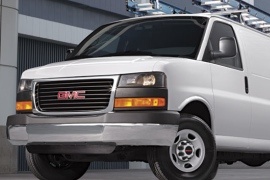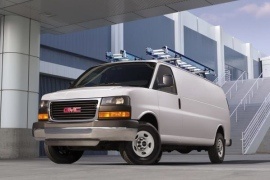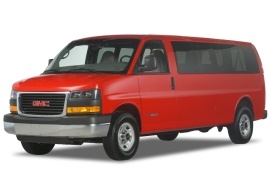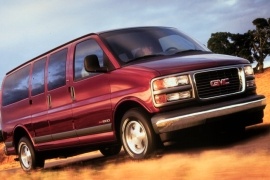GMC Savana Models/Series Timeline, Specifications & Photos
First production year: 1995
Engines: Gasoline, Diesel, Natural gas
Body style: Van
The Savana 1500 was the classic utility van that proved to be successful as an MPV as well. With room for up to 8 passengers, it was also used as a fleet vehicle, shuttle, or limousine vehicles.
The car's origin dated back in 1976 and the basic vehicle remained the same. It was built on a ladder-chassis, with a solid axle in the back and independent front suspension. It was available with 2- or 4-wheel-drive.
The 2013 Savana 1500 was available with a slightly redesigned front fascia. The big headlights were positioned high so they were protected in the event of a minor parking crashes. A big, sliding, door was available on the right side, to ease the access inside the vehicle. Twin-doors on hinges were placed in the rear.
Inside, the Savana 1500 offered room for 8 passengers as standard, with two trim levels: LS and LT. For the front passengers, the former three passengers bench-seat was deleted and only the two individual seats were offered. The classic dashboard was big, high, and flat as in most of the utility vans. But when compared to that, the passenger version had new amenities on it. From the multiple-zone climate control system to the new audio system which includes CD/MP3, a USB port, and SiriusXM satellite radio.
Two Vortec engines were available for the Savana 1500 lineup: a 195-hp 4.3-liter V6 available on the rear-wheel-drive cargo van only and a 310-hp E85 FlexFuel 5.3-liter V8 fitted as standard for the passenger version. The only transmission offered was the 4-speed Hydra-Matic.
The Savana 2500 was the classic utility van that proved to be successful as an MPV as well. With room for up to 12 passengers, it was also used as a fleet vehicle, shuttle, or small bus.
The car's origin dated back in 1976 and the basic vehicle remained the same. It was built on a ladder-chassis, with a solid axle in the back and independent front suspension. It was available with 2- or 4-wheel-drive.
The 2013 Savana 2500 was available with a slightly redesigned front fascia. The big headlights were positioned high so they were protected in the event of a minor parking crashes. A big, sliding, door was available on the right side, to ease the access inside the vehicle. Twin-doors on hinges were placed in the rear.
Inside, the Savana 2500 offered room for 12 passengers as standard, with two trim levels: LS and LT. For the front passengers, the former three passengers bench-seat was deleted and only the two individual seats were offered. The classic dashboard was big, high, and flat as in most of the utility vans. But when compared to that, the passenger version had new amenities on it. From the multiple-zone climate control system to the new audio system which includes CD/MP3, a USB port, and SiriusXM satellite radio. For the utility van, the 2500 offered 1300 lbs of GVWR over the light-duty 1500.
The Savana 3500 was the classic utility van that proved to be successful as an MPV as well. With room for up to 15 passengers on its extended-wheelbase variant.
The car's origin dated back in 1976 and the basic vehicle remained the same. It was built on a ladder-chassis, with a solid axle in the back and independent front suspension. It featured standard electronic stability control.
The 2013 Savana 3500 was available with a slightly redesigned front fascia. The big headlights were positioned high so they were protected in the event of a minor parking crashes. A big, sliding, door was available on the right side, to ease the access inside the vehicle. Twin-doors on hinges were placed in the rear.
Inside, the Savana 3500 offered room for 15 passengers as standard, with two trim levels: LS and LT. For the front passengers, the former three passengers bench-seat was deleted and only the two individual seats were offered. The classic dashboard was big, high, and flat as in most of the utility vans. But when compared to that, the passenger version had new amenities on it. From the multiple-zone climate control system to the new audio system which includes CD/MP3, a USB port, and navigation system. For the utility van, the 3500 offered 800 lbs (362 kg) of GVWR over the Savana 2500. It could tow up to 10.000 lbs (4535 kg).
It was offered with three engine versions: the standard 4,8-liter V8 gasoline, followed by 6.0-liter V8 gasoline, and the heavy-duty 6.6-liter Duramax turbodiesel.
The second generation of the GMC Savana was introduced in 2003, and despite using some old components, it was a big evolution over its predecessor.
The light-utility vehicle term was different between the Asian, European, and American markets. A vehicle such as the GMC Savana would require a different driving license in Europe than in the U.S.A. In its passenger version, the Savana could accommodate up to 15 passengers; in Europe, a regular driver could carry up to eight occupants besides the one behind the wheel.
Big, chunky, and with bigger headlights, the Savana was available as a panel van or passenger van. It was used mainly as a shuttle bus for hotels, schools, and crew-carrier. It was a good choice for motorhome conversions for those who preferred to sleep in a camping area rather than in a hotel, and the straight body panels and the ladder-chassis underneath could withstand a heavy load.
The dashboard was flat and straight, similar to those used in trucks. That was the idea: to create an industrial look for a less family vehicle. On the other hand, it offered enough amenities to be used for weekend trips.
The 2003 Savana was the first generation that featured a 4x4 system, making it more suitable for use as a vehicle in mountain resorts. The independent front axle offered enough comfort for the driver, while the solid rear axle was tough enough to support heavy loads. It was available with manual or automatic transmissions.
GMC built this utility-van-based vehicle for many friends, big families, or shuttle used since the mid-'90s to replace the Vandura.
The Savana was built on the backbone of a truck, with a welded ladder-chassis underneath. It was available in different lengths, shapes, or cutaway versions for conversion vans. Its long wheelbase and the heavy-duty underpinnings made it ideal for anyone, from a contractor team to a church bus.
Its front fascia resembled the face of a GMC pickup-truck, with its dual rectangular headlights at the front and the squared black grille in the middle. The wrapped-around bumpers were made out of metal with some rubber on top. It was available with sliding or double-hinged doors on the sides and twin doors in the rear.
The driver should have clime aboard behind the big wheel and the flat, truck-looking dashboard to get inside. The carmaker tried to make it look like a regular vehicle, but it still looked like a truck with an instrument cluster filled with five dials and an LCD at the bottom of the centrally mounted speedometer. Its steering-column mounted shifter made room for a free passage from left to right. There was no center console, just a center stack to avoid where the designers installed the HVAC controls, a pair of cupholders, and a bin at the bottom.
Under the hood, GMC installed a 4.3-liter V6 engine paired to a standard 4-speed automatic transmission.




